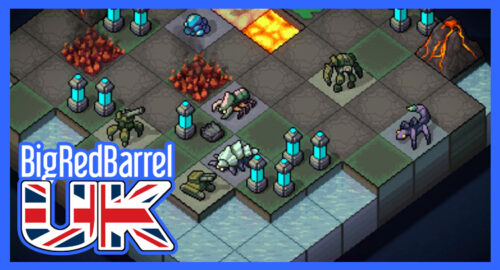EGX Rezzed 2016 is now over for another year. The show was excellent, with a friendly atmosphere and some truly unique games on show. One of the developers we met turned out to be an acquaintance of ours too – Dreadbit, the talented team behind last year’s Ironcast. They were in the PlayStation section showing off their latest offering, Seraph.
[youtube id=”DV2oCHtG714″ align=”center” maxwidth=”530″]
• Developer: Dreadbit
• Publisher: Dreadbit
• Previewed on: PlayStation 4
• Also Available On: PC
• Release Date: 2016
Seraph sees you take control of the titular character as you guide her out of the prison she has found herself in. Her angelic powers have waned so she must restore them is she has any chance to escape. As well as being weaker than she normally is, she discovers that she is trapped inside a human vessel, meaning that if her vessel dies, she will too.
The game is a skill-based, acrobatic shooter, which seems standard enough. However, the key difference here is the fact that you do not aim, at all. This may seem counter-intuitive at first but it actually allows you to concentrate on the combat in a different way. Allowing Seraph to aim leaves you to strategise a bit more – more enemies are pouring in from the left so I need to either go right or find a way above them, for instance.
Seraph uses a wide range of firearms too, though our demo didn’t feature all of them. Personally, I relied on her twin pistols and felt powerful, flipping around the demons attacking me. The game clearly wants you to enjoy moving around the environment, so Seraph’s agility is the focus here. She can double-jump, flip head-over-heals and even blink across the screen (an instant teleport ability, useful for getting out of sticky situations).
One of the criticisms Dreadbit heard regarding Ironcast was the difficulty. From some quarters, the game was considered too hard but others said it was too easy. In Seraph, there is now an on-screen difficulty rating so that the game always feels challenging enough for each type of player. If you happen to be doing better than before, expect the enemies to get harder. Equally though, expect better rewards and experience from this.
The developers also touted just how replayable to game is. Each level is procedurally-generated and features random enemies and bosses. Rewards will also be random too. In my playthrough, I noticed numerous paths to take too so there seemed to be multiple ways to complete each level too. One thing that was stressed to us was the fact that Seraph is not a rogue-like. While Seraph herself can be slain when her vessel is defeated, she will resurrect with less maximum health. There are also hidden checkpoint orbs to discover that save a new start point throughout the campaign too.
Defeating demons also earns you experience which can be used to transmutate yourself. This means that new weapons, miracles (abilities) and protective wards (buffs) can be learned throughout the game. These form the angelic abilities you will need to defeat the various bosses in the game. The one featured in the demo had a segmented life-bar. As you chipped away at its health, you get the chance to pull off powerful, mid-fight attacks that force you to get in close.
Another feature the developers were keen to discuss were the Twitch elements they will be including. When streaming Seraph in Twitch mode, viewers get to vote between levels on whether or not to give you positive or negative modifiers for the next section of the game. For instance, you may receive buffs to your angelic abilities or they may saddle you with tougher enemies or less health.
I was impressed with Seraph. The combat feels fast, frenetic and fun, despite the lack of aiming, the art-style is eye-catching and the depth to the game’s progression system is promising. Let’s hope we don’t have to wait long for more demon-slaying.
Official Game Site









